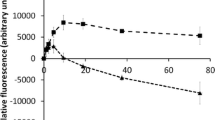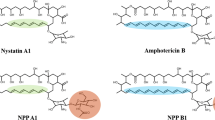Abstract
Aspergillus nidulans var. roseus ATCC 58397 is an echinocandin B (ECB) producer ascomycete with great industrial importance. As demonstrated by ECB/caspofungin sensitivity assays, A. nidulans var. roseus does not possess any inherent resistance to echinocandins, and its tolerance to these lipopeptide antimycotics are even lower than those of the non-producer A. nidulans FGSC A4 strain. Under ECB producing conditions or ECB exposures, A. nidulans var. roseus induced its ECB tolerance via up-regulating elements of the chitin biosynthetic machinery and, hence, through changing dynamically the composition of its own cell wall. Importantly, although the specific β-1,3-glucan synthase activity was elevated, these changes reduced the β-glucan content of hyphae considerably, but the expression of fksA, encoding the catalytic subunit of β-1,3-glucan synthase, the putative target of echinocandins in the aspergilli, was not affected. These data suggest that compensatory chitin biosynthesis is the centerpiece of the induced ECB tolerance of A. nidulans var. roseus. It is important to note that the induced tolerance to ECB (although resulted in paradoxical growth at higher ECB concentrations) was accompanied with reduced growth rate and, under certain conditions, even sensitized the fungus to other stress-generating agents like SDS. We hypothesize that although ECB-resistant mutants may arise in vivo in A. nidulans var. roseus cultures, their widespread propagation is severely restricted by the disadvantageous physiological effects of such mutations.

Similar content being viewed by others
References
Arendrup MC, Perkhofer S, Howard SJ, Garcia-Effron G, Vishukumar A, Perlin D, Lars-Flörl C (2008) Establishing in vitro–in vivo correlations for Aspergillus fumigatus: the challenge of azoles versus echinocandins. Antimicrob Agents Chemother 52:3504–3511
Arendrup MC, Garcia-Effron G, Buzina W, Mortensen KL, Reiter N, Lundin C, Jensen HE, Lass-Flörl C, Perlin DS, Bruun B (2009) Breakthrough Aspergillus fumigatus and Candida albicans double infection during caspofungin treatment: laboratory characteristics and implication for susceptibility testing. Antimicrob Agents Chemother 53:1185–1193
Arikan S, Lozano-Chiu M, Paetznick V, Rex JH (2001) In vitro susceptibility testing methods for caspofungin against Aspergillus and Fusarium isolates. Antimicrob Agents Chemother 45:327–330
Barratt RW, Johnson GB, Ogata WN (1965) Wildtype and mutant stocks of Aspergillus nidulans. Genetics 52:233–246
Boeck LD, Kastner RE (1981) Method of producing the A-30912 antibiotics. U.S. Patent 4,288,549
Borgia PT, Dodge CL (1992) Characterization of Aspergillus nidulans mutants deficient in cell wall chitin or glucan. J Bacteriol 174:377–383
Chomczynski P (1993) A reagent for the single-step simultaneous isolation of RNA, DNA and proteins from cell and tissue samples. Biotechniques 15:532–536
Denning DW (2002) Echinocandins: a new class of antifungal. J Antimicrob Chemother 49:889–891
Diekema DJ, Messer SA, Hollis RJ, Jones RN, Pfaller MA (2003) Activities of caspofungin, itraconazole, posaconazole, ravuconazole, voriconazole, and amphotericin B against 448 recent clinical isolates of filamentous fungi. J Clin Microbiol 41:3623–3626
Fabrizio P, Battistella L, Vardavas R, Gattazzo C, Liou LL, Diaspro A, Dossen JW, Gralla EB, Longo VD (2004) Superoxide is a mediator of an altruistic aging program in Saccharomyces cerevisiae. J Cell Biol 166:1055–1067
Fekete A, Emri T, Gyetvai Á, Gazdag Z, Pesti M, Varga Z, Balla J, Cserháti C, Emődy L, Gergely L, Pócsi I (2007) Development of oxidative stress tolerance resulted in reduced ability to undergo morphologic transitions and decreased pathogenicity in a t-butylhydroperoxide-tolerant mutant of Candida albicans. FEMS Yeast Res 7:834–847
Fekete A, Pócsi I, Emri T, Gyetvai Á, Gazdag Z, Pesti M, Karányi Z, Majoros L, Gergely L, Pócsi I (2008) Physiological and morphological characterization of tert-butylhydroperoxide tolerant Candida albicans mutants. J Basic Microbiol 48:480–487
Galgóczy L, Papp T, Leiter É, Marx F, Pócsi I, Vágvölgyi C (2005) Sensitivity of different Zygomycetes to the Penicillium chrysogenum antifungal protein (PAF). J Basic Microbiol 45:136–141
Garcia-Effron G, Katiyar SK, Park S, Edlind TD, Perlin DS (2008) A naturally-occurring Fks1p proline to alanine amino acid change in Candida parapsilosis, Candida orthopsilosis and Candida metapsilosis accounts for reduced echinocandin susceptibility. Antimicrob Agents Chemother 52:2305–2312
Garcia-Effron G, Lee S, Park S, Cleary JD, Perlin DS (2009) Effect of Candida glabrata FKS1 and FKS2 mutations on echinocandin sensitivity and kinetics of 1,3-β-D-glucan synthase: implication for the existing susceptibility breakpoint. Antimicrob Agents Chemother 53:3690–3699
Gardiner RE, Souteropoulos P, Park S, Perlin DS (2005) Characterization of Aspergillus fumigatus mutants with reduced susceptibility to caspofungin. Med Mycol 43:S299–S305
Ha YS, Covert SF, Momany M (2006) FsFKS1, the 1,3-β-glucan synthase from the caspofungin-resistant fungus Fusarium solani. Eukaryot Cell 5:1036–1042
Howard SJ, Arendrup MC (2011) Acquired antifungal drug resistance in Aspergillus fumigatus: epidemiology and detection. Med Mycol 49:S90–S95
Klich M, Mendoza C, Mullaney E, Keller N, Bennett JW (2001) A new sterigmatocystin-producing Emericella variant from agricultural desert soils. Syst Appl Microbiol 24:131–138
Lewis RE, Albert ND, Kontoyiannis DP (2008) Comparison of the dose-dependent activity and paradoxical effect of caspofungin and micafungin in a neutropenic murine model of invasive pulmonary aspergillosis. J Antimicrob Chemother 61:1140–1144
McCluskey K (2003) The Fungal Genetics Stock Center, from molds to molecules. Adv Appl Microbiol 52:245–262
Moreno AB, del Pozo AM, Borja M, San Segudo B (2003) Activity of the antifungal protein from Aspergillus giganteus against Botrytis cinerea. Phytopathology 93:1344–1353
Ouedraogo JP, Hagen S, Spielvogel A, Engelhardt S, Meyer V (2011) Survival strategies of yeast and filamentous fungi against the antifungal protein AFP. J Biol Chem 286:13859–13868
Pacetti SA, Gelone SP (2003) Caspofungin acetate for treatment of invasive fungal infections. Ann Pharmacother 37:90–98
Park S, Kelly R, Kahn JN, Robles J, Hsu MJ, Register E, Li W, Vyas V, Fan H, Abruzzo G, Flattery A, Gill C, Chrebet G, Parent SA, Kurtz M, Teppler H, Douglas CM, Perlin DS (2005) Specific substitutions in the echinocandin target Fks1p account for reduced susceptibility of rare laboratory and clinical Candida sp. isolates. Antimicrob Agents Chemother 49:3264–3273
Perlin DS (2007) Resistance to echinocandin-class antifungal drugs. Drug Resist Updates 10:121–130
Pfaller MA, Messer SA, Boyken L, Rice C, Tendolkar S, Hollis RJ, Diekema DJ (2003) Caspofungin activity against clinical isolates of fluconazole-resistant Candida. J Clin Microbiol 41:5729–5731
Plaine A, Walker L, Da Costa G, Mora-Montes HM, McKinnon A, Gow NA, Gaillardin C, Munro CA, Richard ML (2008) Functional analysis of Candida albicans GPI-anchored proteins: roles in cell wall integrity and caspofungin sensitivity. Fungal Genet Biol 45:1404–1414
Pócsi I, Leiter É, Kwon NJ, Shin KS, Kwon GS, Pusztahelyi T, Emri T, Abuknesha R, Price R, Yu JH (2009) Asexual sporulation signaling regulates autolysis of Aspergillus nidulans via modulating the chitinase ChiB production. J Appl Microbiol 107:514–523
Pusztahelyi T, Molnár Z, Emri T, Klement É, Miskei M, Kerékgyártó J, Balla J, Pócsi I (2006) Comparative studies on differential expression of chitinolytic enzymes encoded by chiA, chiB, chiC and nagA genes in Aspergillus nidulans. Folia Microbiol 51:547–554
Shedletzky E, Unger C, Delmer DP (1997) A microtiter-based fluorescence assay for (1,3)-β-glucan synthases. Anal Biochem 249:88–93
Stevens DA, Ichinomiya M, Koshi Y, Horiuchi H (2006) Escape of Candida from caspofungin inhibition at concentrations above the MIC (paradoxical effect) accomplished by increased cell wall chitin; evidence for β-1,6-glucan synthesis inhibition by caspofungin. Antimicrob Agents Chemother 50:3160–3161
Tóth V, Nagy CT, Miskei M, Pócsi I, Emri T (2011) Polyphasic characterization of "Aspergillus nidulans var. roseus" ATCC 58397. Folia Microbiol 56:381–388
Walker LA, Gow NAR, Munro CA (2010) Fungal echinocandin resistance. Fungal Genet Biol 47:117–126
Wiederhold NP (2009) Paradoxical echinocandin activity: a limited in vitro phenomenon? Med Mycol 47(Suppl 1)S369–S375
Author information
Authors and Affiliations
Corresponding author
Electronic supplementary material
Below is the link to the electronic supplementary material.
ESM 1
(DOC 43 kb)
Rights and permissions
About this article
Cite this article
Tóth, V., Nagy, C.T., Pócsi, I. et al. The echinocandin B producer fungus Aspergillus nidulans var. roseus ATCC 58397 does not possess innate resistance against its lipopeptide antimycotic. Appl Microbiol Biotechnol 95, 113–122 (2012). https://doi.org/10.1007/s00253-012-4027-y
Received:
Revised:
Accepted:
Published:
Issue Date:
DOI: https://doi.org/10.1007/s00253-012-4027-y




